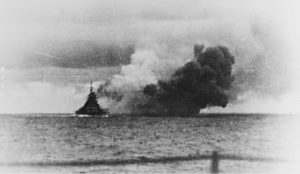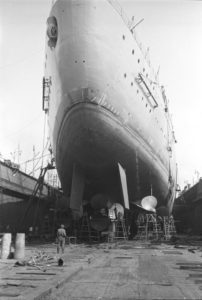The Bismarck was Germany’s “unsinkable” battleship which the Nazis used to wreak havoc on the British Royal Navy in World War II. Now, more than 70 years after over 50 Allied ships sank it following a chase through the Atlantic Ocean, the ship is revealing its secrets.
The Bismarck was used to disrupt Allied shipping in the Atlantic. Sinking it became a priority for the Royal Navy.
At the Battle of Denmark, the HMS Prince of Wales attacked the German ship and struck it three times which caused significant damage to the Nazi battleship. The Bismarck retreated to occupied France to get repairs. On the way, 16 Fairey Swordfish biplane torpedo bombers attacked from the HMS Ark Royal. The next morning, the Bismarck was sent to the bottom of the sea.

About thirty years ago, retired US Navy officer Robert Ballard located the wreck of the Bismarck. But it was only recently that researchers discovered something previously unknown about the ship. National Geographic’s series “Drain the Ocean” revealed the newest discovery.
As explained by the show’s narrator, Avery Brooks, the Bismarck was the largest ship in the German navy. The crew consisted of more than 2,000 men. The 15-inch guns on her deck were capable of firing shells that weighed almost one ton and sending them 24 miles.
The first mission for the Bismarck was destroying British convoys in the Atlantic.
On May 24, 1941, the British ship HMS Hood attacked the Bismarck. The attack did not go well for the British as all but three of the Hood’s crew were killed.
When Prime Minister Winston Churchill heard about the sinking of the Royal Navy’s most iconic ship, he issued orders for the Bismarck to be found and destroyed.
More than 50 British ships joined in the hunt and sank the German ship in 16,000 feet of water. The Bismarck had been struck “many, many times,” according to the show.
Using state of the art technology, researchers were able to scan the ship and show it as if it were sitting on dry land – as if they had been able to “Drain the Ocean.”

Looking at the shipwreck with this technology allows researchers to get a closer look at the damage to the ship. They can see that one torpedo from the Fairey Swordfish planes struck a weak point in the stern. One of the rudders was severely damaged and the other rudder was completely blown off of the ship. She had no way to steer as the British moved in for the kill.
Extensive shelling crippled the Bismarck’s eight guns. Torpedos struck the hull and filled the ship with water. But experts expected to see that only the parts of the ship that were struck by the British would fill with water and the other parts of the ship would still be filled with air. Under the immense pressure of the ocean depths, the air-filled parts of the ship would be crushed.
Another Article From Us: Sold to One of the World’s Largest Private Collectors – Kevin Wheatcroft
But the scans of the shipwreck show that the ship is not crushed. Researchers were able to determine that the torpedo strikes weakened the ship’s hull but the crew deliberately let in water in order to scuttle the mighty warship in order to prevent it from falling into British hands.
Though they agree that, eventually, the damage caused by the British would have sank the Bismarck anyway.
